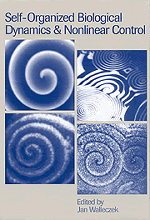 Self-Organized Biological Dynamics and Nonlinear Control
Self-Organized Biological Dynamics and Nonlinear Control Book contents
- Frontmatter
- Contents
- List of contributors
- Preface
- The frontiers and challenges of biodynamics research
- Part I Nonlinear dynamics in biology and response to stimuli
- Part II Nonlinear sensitivity of biological systems to electromagnetic stimuli
- Part III Stochastic noise-induced dynamics and transport in biological systems
- Part IV Nonlinear control of biological and other excitable systems
- 14 Controlling chaos in dynamical systems
- 15 Electromagnetic fields and biological tissues: from nonlinear response to chaos control
- 16 Epilepsy: multistability in a dynamic disease
- 17 Control and perturbation of wave propagation in excitable systems
- 18 Changing paradigms in biomedicine: implications for future research and clinical applications
- Index
14 - Controlling chaos in dynamical systems
Published online by Cambridge University Press: 14 August 2009
- Frontmatter
- Contents
- List of contributors
- Preface
- The frontiers and challenges of biodynamics research
- Part I Nonlinear dynamics in biology and response to stimuli
- Part II Nonlinear sensitivity of biological systems to electromagnetic stimuli
- Part III Stochastic noise-induced dynamics and transport in biological systems
- Part IV Nonlinear control of biological and other excitable systems
- 14 Controlling chaos in dynamical systems
- 15 Electromagnetic fields and biological tissues: from nonlinear response to chaos control
- 16 Epilepsy: multistability in a dynamic disease
- 17 Control and perturbation of wave propagation in excitable systems
- 18 Changing paradigms in biomedicine: implications for future research and clinical applications
- Index
Summary
Introduction
A clown sits precariously atop his unicycle, stopping at the viewing stand to get a few more laughs out of the audience. The more discerning observers notice, however, that the clown never actually stops. Rather, he is in constant motion, moving slightly ahead and slightly back and slightly ahead again in a seemingly uncoordinated, jerky fashion. In fact, the clown's motions are precise corrections he makes to stabilize his otherwise unstable vertical perch. Many other examples of this type of action–reaction behavior come to mind in everyday experience, from the tightrope walker in the same circus to a waiter one-handedly whisking away a wobbling tray loaded with dishes.
The clown's balancing act provides a good analogy for recently developed methods for controlling a type of behavior called deterministic chaos, which was previously thought to be uncontrollable. Contrary to the traditional view of ‘chaos’, deterministic chaos is not totally random but has an underlying, intricate order. Despite this order, predicting the long-term behavior in such systems is essentially impossible, since chaotic systems exhibit an extreme sensitivity to initial conditions, where two systems that differ only infinitesimally evolve in time so as to diverge exponentially from one another. Chaotic behavior arises in systems as diverse as turbulent fluids, electronic circuits, lasers, and oscillatory chemical reactions.
The extreme sensitivity of chaotic systems suggests that they might be difficult if not impossible to control, since any perturbations used for control would grow exponentially in time.
- Type
- Chapter
- Information
- Self-Organized Biological Dynamics and Nonlinear ControlToward Understanding Complexity, Chaos and Emergent Function in Living Systems, pp. 328 - 340Publisher: Cambridge University PressPrint publication year: 2000


